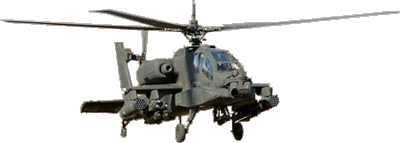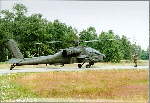|
|

|
|
The AH-64D incorporates a series
of improvements to the AH-64A that make
it more survivable, deployable and maintainable in the field. The first AH-64D for The Netherlands was delivered in June 1998. The first WAH-64 Apache for the United Kingdom is scheduled to be delivered in October 1998. Like its predecessor, the AH-64D carries a lethal array of missiles, rockets and the 1,200 rounds of ammunition for its 30mm M230 automatic cannon. Its ability to communicate digitally with other aircraft and ground forces, and to share that information almost instantly, give the AH-64D a significant advantage over current combat helicopters and will enable it to dominate the 21st century battlefield. In 1996, The Boeing Company signed a five-year, multi-year contract with the U.S. Army for 232 AH-64D Apache, and delivered the first remanufactured aircraft March 21, 1997. Through July 1998, the company had delivered 36 AH-64Ds. The contract will save the U.S. Army millions of dollars over the next five years and give them more aircraft compared to single-year funding over the same period. The multi-year purchase increases the production rate in the first year to 24 aircraft and 232 for the five-year period. Under the multi-year contract, the Army will field two additional combat-ready AH-64D battalions. The contract also includes funding for Boeing to train pilots and maintenance personnel for the first two equipped units, development of interactive electronic technical manuals, development of training devices, first article testing of the production aircraft, initial spares, and a variety of program support tasks for the first production lot. A U.S. Army training center has been established at the Boeing facility in Mesa. The U.S. Army plans to remanufacture its entire AH-64A Apache fleet of approximately 750 aircraft over the next decade. To validate the Apache Longbow capabilities, Boeing built six prototypes: four equipped with an advanced fire control radar system called Longbow, developed by a Lockheed Martin, and two without the radar. All six prototypes flew on or ahead of schedule and demonstrated the advanced capabilities of the improved Apache aircraft. During the U.S. Army’s Force XXI field exercises in 1996 at Fort Irwin, Calif., two AH-64D Apaches put on a tactics, techniques and procedures (TTP) clinic in the California desert. Although official results have not been released, key U.S. Army officers have characterized the new helicopter’s performance as “the quintessential example” of how the U.S. Army will dominate the digital battlefield of the 21st century. |
|||||||||||||||||||||||||||
|
AH-64D Specifications
|
|||||||||||||||||||||||||||
[ HOME ] [ AH-64A ] [ AH-64D ] [ Longbow ] [ WAH-64] [ Info ] [ Armament ]
[ Pictures ] [ Video ] [ IHADSS ] [ Links ]
